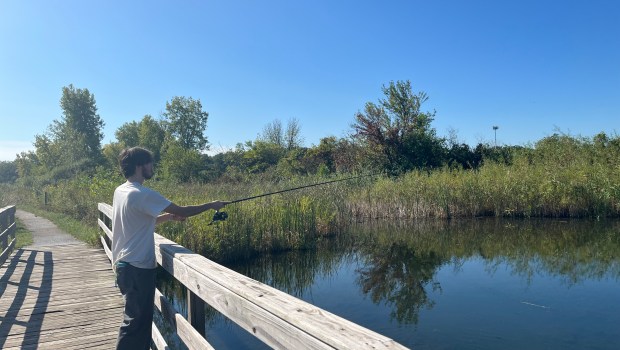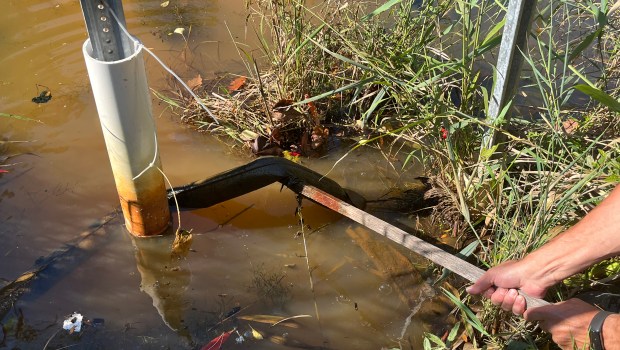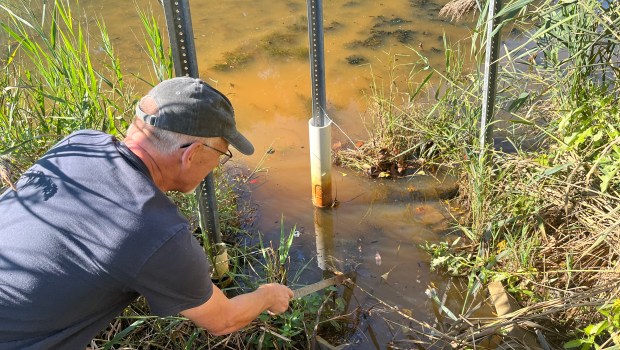After starting out as a 30-acre site just off Halsted Street on the outskirts of the old Washington Park Racetrack, Homewood Izaak Walton Preserve has become a cornerstone of activity in the village and a vibrant community greenspace that now encompasses 193 acres.
The preserve is home to more than 100 bird species and attracts thousands of human visitors each year, according to David Zaber, an environmental scientist who lives in the village and is on the preserve’s board. He said Homewood Izaak Walton Preserve is part of the reason Homewood was declared a Bird City this summer by the Audubon Council of Illinois — one of ten municipalities in the state to receive the designation.
But about four years ago, Zaber noticed orange colored water along with a strong odor and an oily film in one of the ponds in the far northwest corner of the preserve, near Homewood Disposal, a garbage and recycling business.
Tests on a portion of the pond showed high levels of polynuclear aromatic hydrocarbons, a class of organic chemicals that are potentially harmful to humans and animals, Zaber said.
The chemicals are known to cause cancer on the faces and lips of fish in Great Lakes tributaries, and some of the substances are known human carcinogens, he said. They are also toxic to other aquatic life and can accumulate in the food web.
“Everything is at risk when all these chemicals come in,” he said.
After comparing Google Earth images over a number of years, Zaber determined the discoloring started around 2005.
“It’s only a sample — or subsample — of what pollutants we need to look for. Now, given the high levels of these pollutants, that’s telling us that there’s got to be a much more extensive sampling,” Zaber said. “It’s been 20 years of discharge, slow and steady, and that has a chance to move — even the wildlife move it themselves.”
Other heavy metals, including chromium, barium, mercury and lead, were found at the site, along with a substantial amount of iron, which is causing the oily film on the pond and could potentially harm the ecosystem, Zaber said.
Despite notifying the village several years ago, Zaber and the Homewood Izaak Walton board are still searching for answers.
The concern, Zaber said, is that visitors fish out of the ponds, dogs swim in them, and anyone eating the fish could face significant health risks.
Napoleon Haney, Homewood’s village manager, said village officials reached out to the Illinois Environmental Protection Agency a few weeks ago and met with agency representatives last week to gather information and determine next steps.
“We want it resolved; we want our community beautiful,” he said. “We just want to make sure that the right agencies are involved to assist us in resolving any and everything that’s out of compliance. We’re confident that the IEPA will provide some wonderful guidance.”

Zaber and Liz Varmecky, co-founder of the grassroots group South Suburbs for Greenspace, believe the pond’s unnatural color and oily sheen originate from a municipal stormwater outflow that channels runoff from nearby businesses.
While the direct source of contamination is unconfirmed, Varmecky and Zaber suspect it may come from Homewood Disposal, which erected its headquarters along 175th Street near the preserve in 2003, shortly before Zaber noticed discoloration. This is based on their observations of a strong odor, along with discolored water and sediment flowing from a pipe draining stormwater from Homewood Disposal’s property into Izaak Walton, Zaber said.
Varmecky believes the construction of a basement at the company’s headquarters may have allowed potentially contaminated groundwater to enter the surface drainage system and gradually flow into Prairie Lakes, the stormwater detention network within the nature preserve.
“The groundwater was there, but it was underground,” she said. “It wasn’t until they built the building in 2003 that has a basement that the groundwater had to be disturbed.”
Homewood Disposal representatives did not immediately return calls Wednesday.
Haney stressed that the village is not looking to place blame for the contamination; instead, it aims to evaluate the situation and conduct an analysis that leads to clear conclusions.
While only the two small ponds near the disposal business show discoloration, Zaber said he is concerned the larger lakes in the nature preserve — commonly used for fishing by residents — could also be contaminated if the source of the pollution is not identified and addressed.
The IEPA became involved in 2022, ordering the installation of adsorbent booms — barriers typically used to contain and absorb chemical spills in marine environments — to deal with some of the discharge, Zaber said.
Now, the booms appear damaged and sunken under the discolored water.

Still, Varmecky said, any pollutants should have been detected years ago if the village had been monitoring the stormwater pumped into Prairie Lakes, as required in the Small Municipal Separate Storm Sewer Systems permit issued by the IEPA that allows the village to use the lakes for stormwater detention.
Haney said the village is still uncertain whether there are pollutants in the ponds, which is why the IEPA was called in to assess the situation and recommend a course of action if harmful pollutants are found.
John Brinkman, president of Homewood Izaak Walton Preserve’s board, said the next step is to verify the preliminary testing results, which will require the village to hire an engineering firm to conduct more testing.
“It’s going to take time,” Brinkman said.
For Zaber, inaction from state and local authorities regarding contaminants at the nature preserve highlights the struggles of many Southland neighborhoods grappling with industrial pollution while fighting for green space.
“The bottom line is this: We have a situation in the most beloved and important natural preserve in Homewood used by many people, including people of color, who eat fish from those lakes and they’ve allowed it to go,” Zaber said. “There’s no excuse for not detecting it.”
Until the contamination is addressed, Varmecky said the environmentalists are dedicated to protecting the preserve — “a little oasis that doesn’t exist anywhere else,” she said.
smoilanen@chicagotribune.com




